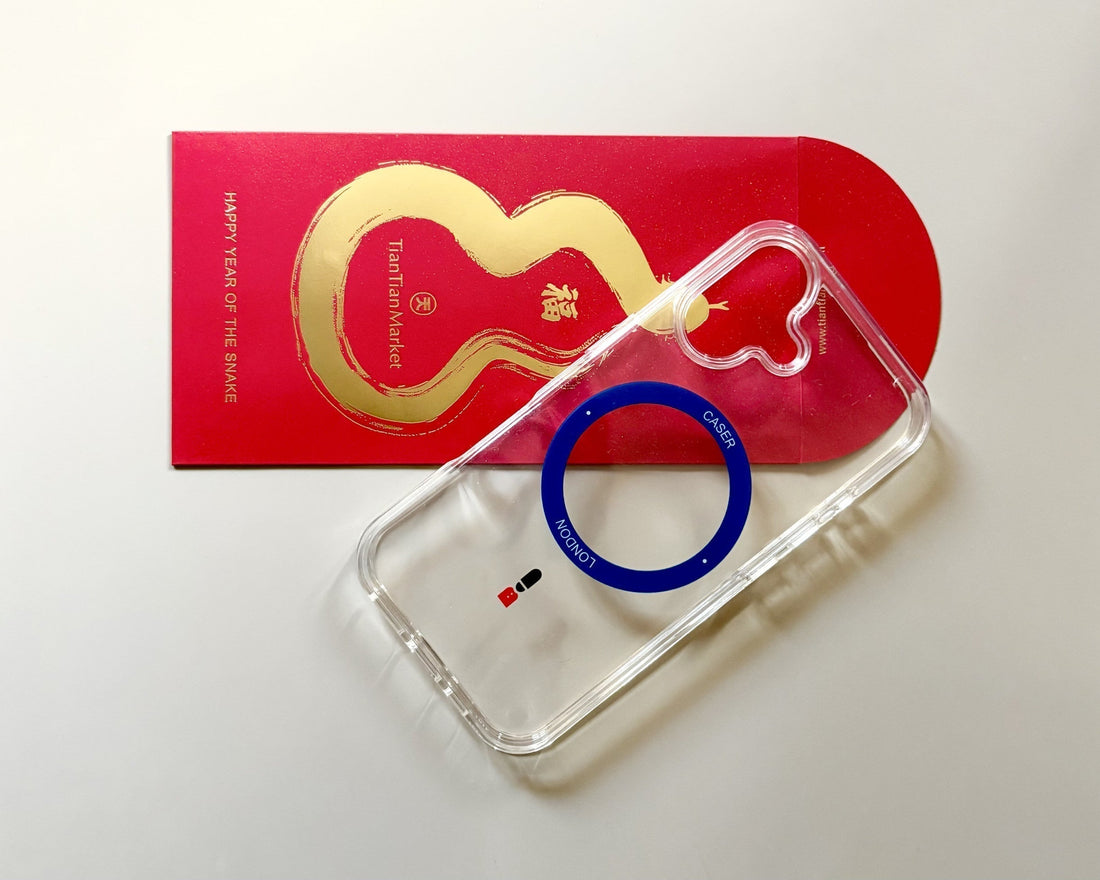
Celebrating Lunar New Year 2025: A Reflection on Tradition and Heritage
Share
As the world welcomes the first day of the Lunar New Year 2025, it is a time of renewal, joy, and reflection. Rooted in centuries-old traditions, this festival is celebrated across China and many other East Asian cultures, each bringing its own unique customs and interpretations. As the founder of CASER LONDON, a brand deeply inspired by my Chinese heritage and my life in London, I take this opportunity to share the significance of Lunar New Year and how its essence resonates with our brand values.
The Meaning of Lunar New Year
Lunar New Year, also known as the Spring Festival (春节, Chūnjié) in China, marks the beginning of the lunar calendar. Unlike the Gregorian New Year celebrated on January 1st, this festival is based on the cycles of the moon, meaning the date changes each year. In 2025, the Lunar New Year falls on January 29th, ushering in the Year of the Snake, a symbol of wisdom, elegance, and resilience.
For millions around the world, this period is a time to honour family, pay respect to ancestors, and embrace the promise of a fresh start. The celebrations last for 15 days, culminating in the Lantern Festival, where glowing lanterns light up the night sky, signifying hope and good fortune.
Traditions and Celebrations
1. Reunion Dinners: A Feast of Togetherness
The Lunar New Year celebrations begin with the highly anticipated reunion dinner on New Year's Eve. Families come together, sometimes travelling vast distances, to share a lavish meal symbolising unity and prosperity. Dishes such as dumplings (饺子, jiǎozi), fish (鱼, yú, representing surplus and abundance), and glutinous rice cakes (年糕, niángāo, symbolising progress) are commonly served.
Traditional dishes vary across regions. In northern China, dumplings are a staple, while southern China favours sticky rice cakes. Each dish carries symbolic meaning, reflecting hopes for prosperity, health, and happiness in the coming year.
2. Red Packets and Blessings
One of the most cherished customs is the giving of red envelopes (红包, hóngbāo, just like the one in the picture above) filled with money. These are traditionally given by elders to younger family members as a token of good luck and prosperity. The colour red itself is believed to ward off evil spirits and invite positive energy.
Beyond family settings, red packets are now given digitally via mobile apps, showcasing how ancient traditions adapt to modern technology while maintaining their core purpose.
3. Fireworks and Lion Dances
No Lunar New Year celebration is complete without fireworks and lion dances. Firecrackers are set off to scare away the mythical beast Nian (年), which, according to legend, would terrorise villages at the start of each year. Meanwhile, lion dances, performed with vibrant costumes and rhythmic drumbeats, symbolise strength and fortune, bringing blessings to homes and businesses.
4. Temple Visits and Prayers
Many families visit temples during Lunar New Year to pray for a prosperous year ahead. Offerings are made to deities, and incense is burned to bring blessings and spiritual protection. In London, many Chinese communities visit temples such as the Fo Guang Shan Temple to uphold these traditions in a Western setting.
Lunar New Year in London
While traditionally a Chinese festival, Lunar New Year has become a major event in cities worldwide, including London. The capital hosts one of the largest Lunar New Year celebrations outside Asia, particularly in Chinatown and Trafalgar Square. Festivities include parades, cultural performances, and food markets offering an authentic taste of Chinese cuisine.
For British-Chinese individuals like myself, Lunar New Year is a beautiful blend of heritage and modern life. It is a chance to reconnect with traditions while celebrating in a global, multicultural environment. Whether sharing a hot pot meal with friends or visiting a temple for blessings, the spirit of the festival remains alive, even far from home.
How CASER LONDON Embraces Heritage and Innovation
At CASER LONDON, we take pride in our commitment to design, sustainability, and cultural appreciation. My Chinese heritage influences the brand’s philosophy—rooted in craftsmanship, respect for materials, and a deep appreciation for tradition while embracing modernity.
Much like the Lunar New Year’s emphasis on renewal, our products are designed with longevity in mind, ensuring that every phone case is not just a stylish accessory but a reflection of mindful consumption. We use recycled materials to reduce environmental impact, aligning with the principles of balance and harmony found in Chinese philosophy.
Our designs often take inspiration from cultural elements. The minimalistic yet elegant aesthetic reflects both British sophistication and Chinese artistry, making each case a statement of heritage and modernity combined.
Furthermore, the fusion of British and Chinese influences within CASER LONDON mirrors the way Lunar New Year is celebrated globally—a blend of history, innovation, and inclusivity. We believe that embracing diverse cultural influences leads to more meaningful, innovative, and sustainable designs.
The Year of the Snake: What It Symbolises
The Snake is known for its intelligence, grace, and ability to adapt. People born in the Year of the Snake are often perceived as wise, intuitive, and resilient. As we step into 2025, these qualities serve as inspiration—not just for personal growth but also for businesses and creative ventures like CASER LONDON.
As a brand, we embrace the adaptability and strategic thinking symbolised by the Snake. The ever-changing market requires constant evolution, and like the Snake, we strive to stay ahead, refining our designs and sustainability efforts to create timeless, high-quality products.
Wishing You a Prosperous Lunar New Year
As we step into the Year of the Snake, I wish all our customers and supporters a year filled with wisdom, resilience, and good fortune. May this new year bring fresh opportunities, meaningful connections, and prosperity to all.
From CASER LONDON to you—Happy Lunar New Year! 新年快乐 (Xīnnián kuàilè)!
Further Reading:
